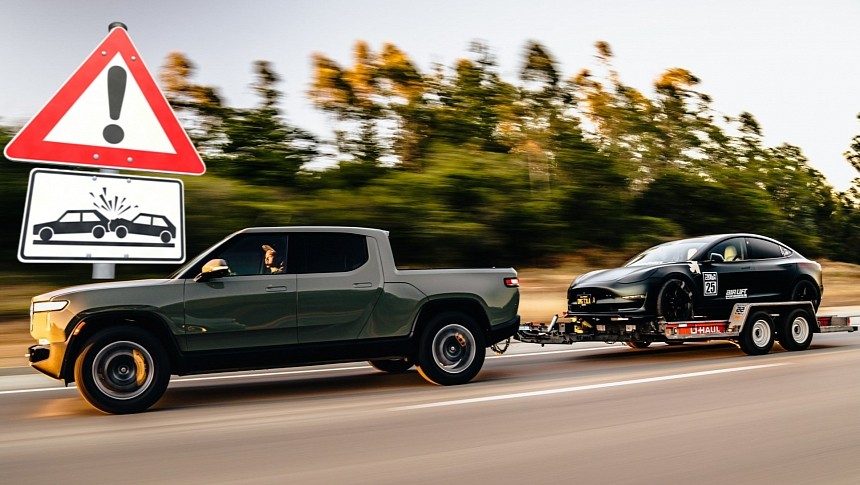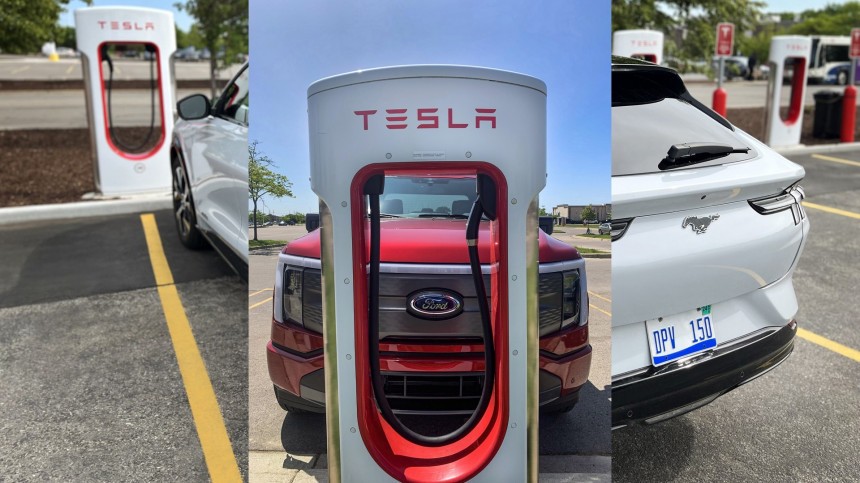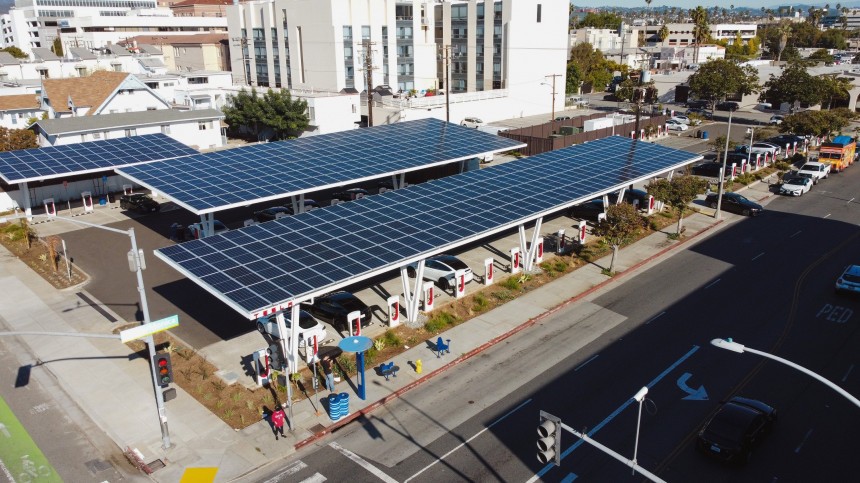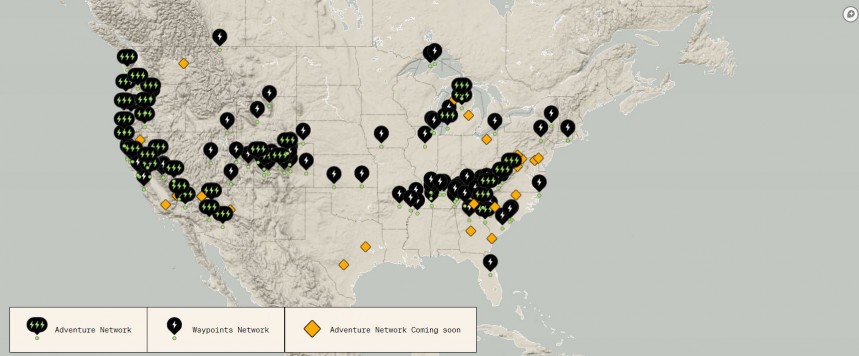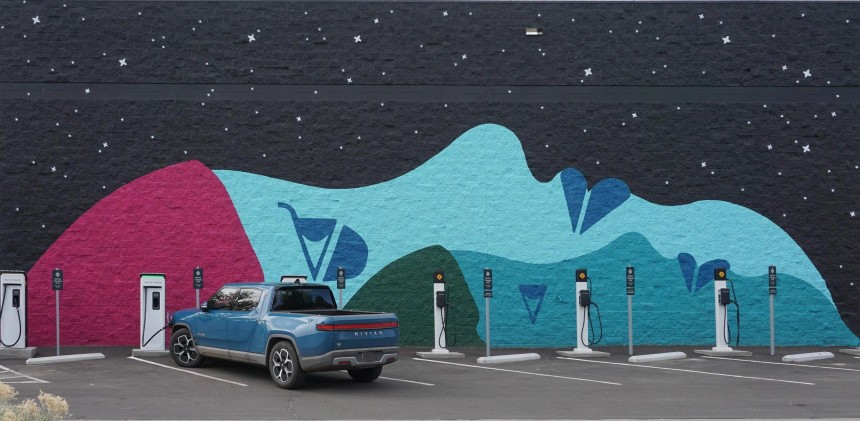Existing customers, prospective buyers, investors, and people who trade automotive stocks have been talking (maybe too much) lately about four companies: Ford, General Motors (GM), Tesla, and Rivian. It's all revolving around fast charging, plugs, and ports. Many are advocating that Rivian follows in Ford's and GM's footsteps. But that is not the right move. Moreover, the discussion should involve Lucid too. Let's dive in.
Ford surprised nearly everyone when it announced that all the electric vehicles (EVs) it will make from 2025 onwards would have the North American Charging Standard (NACS) port. The more interesting bit is that its existing EV customers with a CCS-equipped vehicle will receive an adapter to use the Supercharger network starting "early next year." Besides that, soon-to-come software updates will guarantee that Ford owners can pay for their Supercharging experience via Ford's dedicated apps. Blue Oval buyers won't have to deal with Tesla's digital ecosystem. All this meant that the Dearborn-based brand effectively called it quits on the very popular Combined Charging System (CCS) port seen on virtually all of Tesla's rival vehicles.
Just a couple of days later, General Motors joined the two brands and confirmed it would do the same thing across the board. These announcements felt a bit too coordinated not to have been discussed extensively prior to reaching the public. But, before impressing existing and prospective Ford and GM buyers, what this news did is that it opened the floodgates for smaller industry players to follow suit.
The OG backer of Tesla's port and charging network – Aptera Motors – might have had its people feel just a bit smug about the early decision to go with the NACS after seeing that big names such as ABB, FLO, Blink Charging, Wallbox, Evercharge, and Autel Energy rushed to announce that they're going to implement the NACS too (but without ditching CCS1 entirely). More will surely follow until the end of the year.
Even the federal government stepped in and said the Supercharger network remains eligible for all the available funds as long as it installs CCS ports too, which Tesla already did in some parts of the country through the "Magic Dock."
Even though there's no money on the table for supplying the "fundamentally better in every way" NACS hardware to other brands, Tesla will earn a lot of cash from customers that will use Superchargers. Plus, there might be some software licensing fees that we need to be told of. Tesla will still have a cash flow source to rely on when new EVs aren't bought in large numbers.
The now Texas-based manufacturer has 2,000 charging sites active in North America at the time of writing. The figure is growing daily, and the best thing about it is that users do not complain about it as much as they do when dealing with Electrify America – the nation's second-largest fast-charging network operator. Couple that with the fact that the number of available plugs is simply higher with Tesla's Superchargers, and anyone can understand why American automakers felt like they should finally side with the most valuable auto brand in the world.
After all, many customers who switched and got an EV regularly pointed at range anxiety remaining a real thing despite all-electric vehicles having longer driving ranges nowadays. Similarly, some of those who didn't switch to zero-tailpipe emission motoring were asked if they would consider an all-electric car and said "no" or "not yet" because of the charging stigma.
Moreover, people often indicated the time that one must spend while the vehicle is plugged in could be too long compared to filling up with gas, and, of course, reminded about the reliability of these charging providers.
So, if everything sounds so good for the NACS supporters, why should Rivian side with CCS and spend money on developing its charging network? If mighty Ford couldn't pull it off, how would a startup? Let's see.
But besides making vans, trucks, SUVs, and a lot of software, Rivian is also investing in a charging network. The Waypoints are Level 2 chargers (like Tesla's Destination stalls), while the Rivian Adventure Network (RAN) comprises DC fast chargers (DCFCs). One thing they focused on from the get-go is minimizing the carbon footprint of their vehicles. It is widely known that because mining for metals is involved, a battery-electric vehicle leaves the factory with a larger carbon footprint than an internal combustion engine automobile. To tip the scales in their EVs' favor and to help the environment, Rivian committed to making its charging network powered by 100% renewable energy. Basically, your ownership experience will be as guilt-free as possible.
Sadly, the EV maker didn't manage to fast-track the deployment of its stalls, but it's getting better each month. There are still many states where a Rivian-branded DCFC is missing, so make sure you're covered if you live in places like Texas, New Mexico, Minnesota, Alabama, or South Dakota.
However, the most remarkable thing about Rivian's charging network is that it tries to find remote locations where R1T or R1S owners might go. You might stumble upon a Level 2 charger near national parks or in areas where you wouldn't think one should be available.
When it's all said and done, Rivian should have over 3,500 DCFCs in the U.S. and over 10,000 Waypoints deployed in North America. Initially, this network was reserved only for the company's customers, but two months ago, Rivian decided to allow everyone to charge at its locations. It was also supposed to start charging people for electrons, but nobody has paid for this perk until today.
So, it's shaping up to be a serious competitor for the Supercharger and Electrify America networks. And it should follow this path until the end. The U.S. is known for fostering competition between entities that want to reach more customers with their products or services. If everyone goes in only one direction, innovation might no longer be in the spotlight.
Rivian should let Tesla fight to convince its customers that a stop at a Supercharger might be worth it once in a while. After all, the Magic Dock being implemented nationwide needs some incentive. If everyone switches to NACS, then there's no reason left for Tesla to invest in adding the adapter to its stalls. Besides, only a few people will ponder why most automakers followed Tesla's lead. That'll only cement the automaker's position as the leading EV brand.
There's also the risk of having just one prominent charging provider that can capture the entire market because it is present virtually everywhere. To avoid situations where surcharges might appear, Tesla needs competition. That's why both Rivian and Electrify America are vital. The other up-and-coming suppliers must also be allowed to find their places in this ecosystem. Imagine the gas price if only Chevron or Shell existed nationwide.
It's also important to consider the money already invested into designing and deploying the existing Waypoints and RAN chargers. Tooling and supplier partnerships shouldn't be thrown out the window, especially since the marque isn't a legacy OEM like Tesla's newest industry friends.
There's another critical issue that neither Ford nor GM discussed when confirming the switch to NACS – bidirectional charging. Tesla is known for refusing to let its customers turn their cars into big electricity generators when the grid taps out because it also sells Powerwalls. But in Irvine, Detroit, and Michigan, they do not plan on ignoring the vehicle-to-home (V2H) function. It's unclear if it will work with NACS-equipped cars, but we know it functions on those with the CCS port.
This uncertainty is yet another good reason for Rivian to continue developing its fast-charging network because other brands like Toyota or Hyundai may not be willing to confuse their customers about their vehicles' capabilities. Why not try to appease other brands to join you in offering a strong competitor for the Supercharger network? Unless, of course, Electrify America wakes up and fixes all of its issues.
And the final good reason for which Rivian shouldn't switch to NACS comes directly from the company – it just doesn't like to share a lot with other players out there. This is why there's no CarPlay in R1 series vehicles, for example. Even though their interface software is objectively not as good, Rivian still tells owners to put up with it.
The NACS-equipped cars will be able to charge at DCFCs like the ones Electrify America and Rivian have today, and vehicles with a CCS port will be able to join the Supercharger feast. In both instances, all it takes is an adapter. That could be the missing piece that will fix everything in the end. But we know that friendship isn't the name of the game in the auto industry.
Main photo credit: Steven Kwon
Just a couple of days later, General Motors joined the two brands and confirmed it would do the same thing across the board. These announcements felt a bit too coordinated not to have been discussed extensively prior to reaching the public. But, before impressing existing and prospective Ford and GM buyers, what this news did is that it opened the floodgates for smaller industry players to follow suit.
The OG backer of Tesla's port and charging network – Aptera Motors – might have had its people feel just a bit smug about the early decision to go with the NACS after seeing that big names such as ABB, FLO, Blink Charging, Wallbox, Evercharge, and Autel Energy rushed to announce that they're going to implement the NACS too (but without ditching CCS1 entirely). More will surely follow until the end of the year.
Tectonic plates do what they know best. They shift
Elon Musk and the people who trusted him when putting stalls across the country was perceived as a fool's errand are now rightfully joyous to see that the bet worked out. At the same time, early adopters now become catalysts of an accelerating EV adoption. That's some feat! And, my oh my, what a shameful outcome for legacy automakers this whole situation is! They ignored Tesla at first, then laughed at the EV-only brand, started fighting it, and now Tesla's winning.Even though there's no money on the table for supplying the "fundamentally better in every way" NACS hardware to other brands, Tesla will earn a lot of cash from customers that will use Superchargers. Plus, there might be some software licensing fees that we need to be told of. Tesla will still have a cash flow source to rely on when new EVs aren't bought in large numbers.
The now Texas-based manufacturer has 2,000 charging sites active in North America at the time of writing. The figure is growing daily, and the best thing about it is that users do not complain about it as much as they do when dealing with Electrify America – the nation's second-largest fast-charging network operator. Couple that with the fact that the number of available plugs is simply higher with Tesla's Superchargers, and anyone can understand why American automakers felt like they should finally side with the most valuable auto brand in the world.
After all, many customers who switched and got an EV regularly pointed at range anxiety remaining a real thing despite all-electric vehicles having longer driving ranges nowadays. Similarly, some of those who didn't switch to zero-tailpipe emission motoring were asked if they would consider an all-electric car and said "no" or "not yet" because of the charging stigma.
So, if everything sounds so good for the NACS supporters, why should Rivian side with CCS and spend money on developing its charging network? If mighty Ford couldn't pull it off, how would a startup? Let's see.
Is there a good reason?
Today, Rivian is one of the most promising American automakers that appeared after Tesla. Together with Lucid, these three entities signify progress, courage, and innovation in an era where being environmentally friendly is very important. The Irvine-based all-electric truck and van manufacturer received much praise for the R1T, but most of the hype surrounding the young marque today is thanks to the three-row R1S. It's simply above many competitors; some might even consider it the best all-electric SUV on sale today.But besides making vans, trucks, SUVs, and a lot of software, Rivian is also investing in a charging network. The Waypoints are Level 2 chargers (like Tesla's Destination stalls), while the Rivian Adventure Network (RAN) comprises DC fast chargers (DCFCs). One thing they focused on from the get-go is minimizing the carbon footprint of their vehicles. It is widely known that because mining for metals is involved, a battery-electric vehicle leaves the factory with a larger carbon footprint than an internal combustion engine automobile. To tip the scales in their EVs' favor and to help the environment, Rivian committed to making its charging network powered by 100% renewable energy. Basically, your ownership experience will be as guilt-free as possible.
However, the most remarkable thing about Rivian's charging network is that it tries to find remote locations where R1T or R1S owners might go. You might stumble upon a Level 2 charger near national parks or in areas where you wouldn't think one should be available.
When it's all said and done, Rivian should have over 3,500 DCFCs in the U.S. and over 10,000 Waypoints deployed in North America. Initially, this network was reserved only for the company's customers, but two months ago, Rivian decided to allow everyone to charge at its locations. It was also supposed to start charging people for electrons, but nobody has paid for this perk until today.
So, it's shaping up to be a serious competitor for the Supercharger and Electrify America networks. And it should follow this path until the end. The U.S. is known for fostering competition between entities that want to reach more customers with their products or services. If everyone goes in only one direction, innovation might no longer be in the spotlight.
Rivian should let Tesla fight to convince its customers that a stop at a Supercharger might be worth it once in a while. After all, the Magic Dock being implemented nationwide needs some incentive. If everyone switches to NACS, then there's no reason left for Tesla to invest in adding the adapter to its stalls. Besides, only a few people will ponder why most automakers followed Tesla's lead. That'll only cement the automaker's position as the leading EV brand.
Those wisest among us learn from others' mistakes
Rivian also has the upper hand here. It has seen what Electrify America did wrong and can avoid those mistakes. It has the potential to prove CCS is reliable and as good as NACS, especially since it still sits on a pile of cash that needs to be spent wisely. Moreover, since Ford and GM went with Tesla's solution, Rivian gets more negotiation power with stall suppliers because they might not be so inclined to suddenly give up on the CCS plug and associated software.It's also important to consider the money already invested into designing and deploying the existing Waypoints and RAN chargers. Tooling and supplier partnerships shouldn't be thrown out the window, especially since the marque isn't a legacy OEM like Tesla's newest industry friends.
There's another critical issue that neither Ford nor GM discussed when confirming the switch to NACS – bidirectional charging. Tesla is known for refusing to let its customers turn their cars into big electricity generators when the grid taps out because it also sells Powerwalls. But in Irvine, Detroit, and Michigan, they do not plan on ignoring the vehicle-to-home (V2H) function. It's unclear if it will work with NACS-equipped cars, but we know it functions on those with the CCS port.
This uncertainty is yet another good reason for Rivian to continue developing its fast-charging network because other brands like Toyota or Hyundai may not be willing to confuse their customers about their vehicles' capabilities. Why not try to appease other brands to join you in offering a strong competitor for the Supercharger network? Unless, of course, Electrify America wakes up and fixes all of its issues.
And the final good reason for which Rivian shouldn't switch to NACS comes directly from the company – it just doesn't like to share a lot with other players out there. This is why there's no CarPlay in R1 series vehicles, for example. Even though their interface software is objectively not as good, Rivian still tells owners to put up with it.
The NACS-equipped cars will be able to charge at DCFCs like the ones Electrify America and Rivian have today, and vehicles with a CCS port will be able to join the Supercharger feast. In both instances, all it takes is an adapter. That could be the missing piece that will fix everything in the end. But we know that friendship isn't the name of the game in the auto industry.
Main photo credit: Steven Kwon
